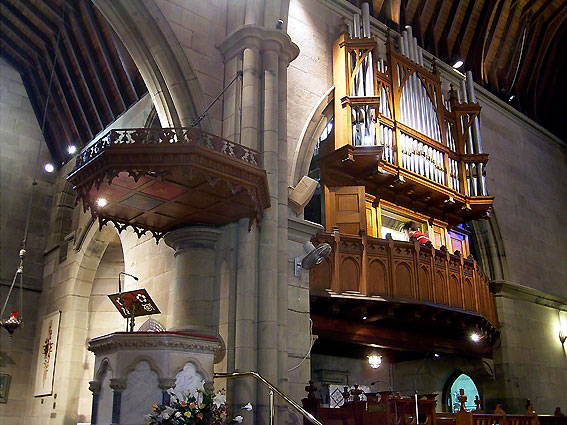All Saints' Anglican Church
Singleton
1912 Griffin & Leggo, reb. 1969 S.T. Noad & Son, 1995 Ian Brown & Assoc.
2m., 14 sp. st., 11c., el.pn.
Historical and Technical Documentation by Kelvin Hastie
© OHTA 2005 (last updated October 2005)

All Saints’ Anglican Church, Singleton
(drawing by Graeme Rushworth)
Local pastoralist A.A. Dangar offered to underwrite the cost of a new church building. The foundation stone was laid on 13 May 1911 and the building first used for public worship on 16 April 1913. The total cost of the building and fittings amounted to £25,450, a colossal amount at the time. The building was designed by the Diocesan Architect, Frederick George Castleden, who had migrated from England in the 1880s; it is one of the most important Australian parish churches of the period. Designed in a restrained Decorated-Gothic idiom, the building is of stone throughout and consists of a crenellated west end tower (modelled upon that of St Neot's Church in Cornwall), a lofty nave and aisles with internal flying buttresses, an imposing chancel, and an eastern ambulatory placed behind the high altar. The excellent fittings include oak pews and stalls by Mr G. Broomfield of Singleton. While many stained glass windows came from the original church, they were remade and fitted into the new church by F.J. Tarrant of Darlinghurst, who augmented these with some new ones of his own. The chancel is floored in Australian marble, while the pulpit and lectern were retained from the previous church. In the church grounds is the Dangar mausoleum, in the form of a classical temple.
[1]
One of the most prominent organists at All Saints’ was Dr C.A. Jarman, well known as a teacher, organist and composer – in addition to his service with the Anglicans, he had long associations with the Methodist Church through consulting on a number of organ installations and for writing descants to several hymn tunes in The Methodist Hymn Book. Graeme Rushworth, in an entry prepared for A Supplement to Historic Organs of New South Wales: the instruments, their makers and players, 1791-1940 (Organ Historical Trust of Australia, forthcoming), says the following of Jarman’s term in Singleton:
“Jarman moved to the Hunter Valley town of Singleton in 1918 to take up his appointment as organist and choirmaster at All Saints’ Anglican Church, with its Griffin & Leggo organ of 1913 (2/12/4/tp) in a splendid Neo-Gothic case designed by the church’s architect, F G Castleden. Jarman later said that although he had played ‘some of the finest and largest organs in the world, he had never found one to equal the satisfaction received when playing the one at All Saints’ Church’. Here Jarman served for three terms totalling 17 years (1918-21; c.1947-55, and 1961-64). He had a deep affection for All Saints’, saying ‘Of all the beautiful parish churches in Australia, it is easily the finest; very definitely a replica of an English parish church’. Those who visit this church will surely share his opinion.”

© PdL 2005
All Saints’ has been home to three pipe organs. The first was a small instrument by E.F. Walcker & Cie, of Germany, which served from 1868 to 1890, and which now stands (with significant modifications) in St Stephen’s Anglican Church, Mittagong. [2] The second was a substantial two manual English instrument of 17 speaking stops, built by Nicholson & Co., of Worcester, and removed in 1910 to St Paul’s Anglican Church, Stockton, where it survives virtually unaltered today. The third was the present instrument, placed in an elevated loft to the north of the chancel, built in 1913 by Griffin & Leggo, of Sydney, to the design of Edward King, then organist of Christ Church Cathedral, Newcastle. [3]
In 1969 the organ was rebuilt by S.T. Noad & Son, of Sydney, who provided electric action, a new console, removed the Swell Voix Celeste for a Piccolo 2, and added two stops to the pedal. In 1995 the instrument was again rebuilt, this time by Ian D. Brown & Associates, who provided a new console and electrical components, while enlarging the Great and Pedal divisions with Forster & Andrews pipework, formerly in the first organ of the Great Hall, University of Sydney. In 2001 the firm added a Trumpet 8 to the Great. [4]

Griffin & Leggo 1912, S.T. Noad & Son 1969, Brown & Associates 1995 (2/22 electric)
| GREAT Open Diapason Stopped Diapason Dulciana Principal Stopped Flute Fifteenth Mixture Trumpet SWELL Violin Diapason Lieblich Gedact Salicional Gemshorn Piccolo Oboe Tremulant PEDAL Bourdon Principal Bass Flute Quint Fifteenth Flute |
8 8 8 4 4 2 III 8 8 8 8 4 2 8 16 8 8 5-1/3 4 4 |
+ * ¶ * * § A B A A B A |
# ^ ^ # # |
COUPLERS
Swell to Pedal
Great to Pedal
Swell to Great
Swell Super Octave
Swell Sub Octave
Swell Unison Off
Electro-pneumatic action
Compass 58/30
Capture combination action by Christie Music Transmission Systems Ltd with 60 memory channels
5 thumb pistons to Great
5 thumb pistons to Swell
5 thumb pistons to Pedal
8 general pistons
Swell to Pedal and Great to Pedal reversible pistons
Balanced Swell Pedal
+ Hohl Flute 8 before 1995
* Added by Ian D. Brown & Associates 1995
¶ Harmonic Flute 4 before 1995
§ Added by Ian D. Brown & Associates 2001
# Added by Ian Brown & Associates 1995
^ Obtained by extension, S.T. Noad & Son 1969
[1] Dorothy Clayworth, A History of All Saints. Singleton: Argus Print, 1978. Additional material supplied by Ray Robinson to Kelvin Hastie, June 2012, from Ray H. Robinson, " All Saints' Anglican Church Singleton 90th Anniversary 2003", unpublished pamphlet, 16pp, 2003.
[2] Rushworth, Historic Organs, 331.
[3] Ibid., 161 and 313.
[4] Specification and other details in Plenum, the journal of the Hunter District Organ Music Society, 23/3 (November 2001): 2. Further details from ibid., 19/5 (November 1995): 8-9.
